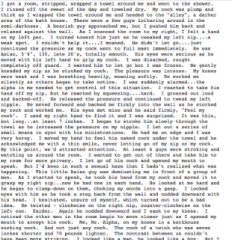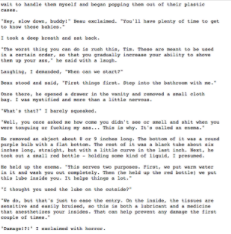Legibility
or
Invite Me In!
IOMfAtS
If you want me to read your stuff, think about how it looks on the page.
"You mean I don't just have to write this stuff, I have to lay it out well, too?"
Look at it this way. You've spent time and effort and the sweat of your brow creating a wonderful story, with well rounded characters, and beautiful dialogue. Do you want to fall at this hurdle?
We're talking about paragraphs. And we're not just talking about the inviolate rule that a new speaker in dialogue gets a new paragraph. You do know about that one? It's part of legibility.
We're talking about having enough white space on the page to let folk read the piece at all. Look at these two snippets from published tales:

|

|
I've ensmallened the text so you don't try to read it. I do know you'll try, though! Even if you zoom in it's still fuzzy. What I want you to look at is presentation. They are direct comparisons of text files presented on a story site. Which one puts you off? Which one invites you in?
Now look at your own work. Does it invite you in? Is there enough white space on the page?
We create white space by using paragraphs. We were taught about those at school.
Paragraphs are an art. Broadly, one thought means one paragraph. Yet each paragraph should also make you want to read the next, should lead in to the next. That leads us to sentences and sentence structure, too.
Search engines will show you loads of stuff about paragraphs, more stuff than anyone really needs. Some of that stuff is for technical writing, which is not what we are doing. We're writing stories. I searched for this: how to use paragraphs in English. The search engine result I like best is this:
It comes from the Cambridge Dictionary and is reproduced here under the doctrine of Fair Use, because it is being used educationally and being discussed.Paragraphs
We organise what we write into sentences and paragraphs. A paragraph begins on a new line within the text and there is often a blank line between paragraphs. A paragraph usually contains more than one sentence and it is usually about one topic.
The first sentence in a paragraph is sometimes called the key or topic sentence because it gives us the key to what the paragraph will be about. The other sentences usually relate to the key sentence. There is usually a conclusion in the final sentence of a paragraph and sometimes there is a link to the next paragraph.
I like it because it's simple. We want to keep it simple.
Finally, from me, can you use only a single word in a paragraph?
Yes.


